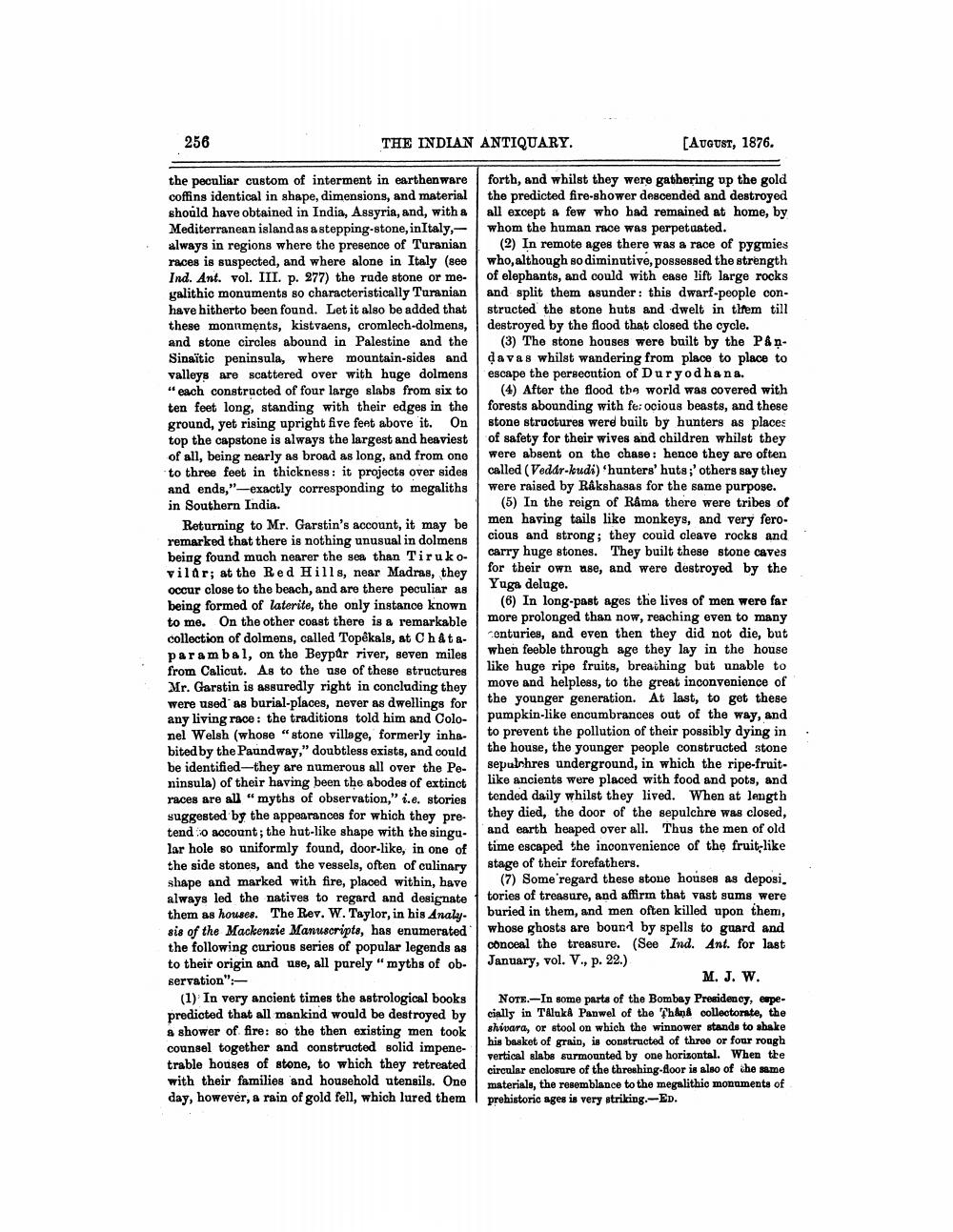________________
256
THE INDIAN ANTIQUARY.
[August, 1876.
the peculiar custom of interment in earthenware coffins identical in shape, dimensions, and material should have obtained in India, Assyria, and, with a Mediterranean islandas astepping-stone, in Italy,- always in regions where the presence of Turanian races is suspected, and where alone in Italy (see Ind. Ant. vol. III. p. 277) the rude stone or meyalithic monuments so characteristically Turanian have hitherto been found. Let it also be added that these monnments, kistvaens, cromlech-dolmens, and stone circles abound in Palestine and the Sinaïtic peninsula, where mountain-sides and valleys are scattered over with huge dolmens "each constructed of four large slabs from six to ten feet long, standing with their edges in the ground, yet rising upright five feet abore it. On top the capstone is always the largest and heaviest of all, being nearly as broad as long, and from one to three feet in thickness: it projects over sides and ends,"-exactly corresponding to megaliths in Southern India.
Returning to Mr. Garstin's account, it may be remarked that there is nothing unusual in dolmens being found much nearer the sea than Tirukovilar; at the Red Hills, near Madras, they occur close to the beach, and are there peculiar as being formed of laterite, the only instance known to me. On the other coast there is a remarkable collection of dolmens, called Topêkals, at Châtaparambal, on the Beypur river, seven miles from Calicut. As to the use of these structures Mr. Garstin is assuredly right in concluding they were used as burial-places, never as dwellings for any living race: the traditions told him and Colonel Welsh (whose "stone village, formerly inhabited by the Paundway," doubtless exists, and could be identified-they are numerous all over the Peninsula) of their having been the abodes of extinct races are all "myths of observation," i.e. stories suggested by the appearances for which they pretendo account; the hut-like shape with the singu. lar hole so uniformly found, door-like, in one of the side stones, and the vessels, often of culinary shape and marked with fire, placed within, have always led the natives to regard and designate them as houses. The Rev. W. Taylor, in his Analy. sis of the Mackenzie Manuscripts, has enumerated the following curious series of popular legends as to their origin and use, all purely "myths of observation":
(1) In very ancient times the astrological books predicted that all mankind would be destroyed by A shower of fire: Bo the then existing men took counsel together and constructed solid impenetrable houses of stone, to which they retreated with their families and household utensils. One day, however, a rain of gold fell, which lured them
forth, and whilst they were gathering up the gold the predicted fire-shower descended and destroyed all except a few who had remained at home, by whom the human race was perpetuated.
(2) In remote ages there was a race of pygmies who, although so diminutive, possessed the strength of elephants, and could with ease lift large rocks and split them asunder: this dwarf-people con. structed the stone huts and dwelt in them till destroyed by the flood that closed the cycle.
(3) The stone houses were built by the P&n. davas whilst wandering from place to place to escape the persecution of Duryodhana.
(4) After the flood the world was covered with forests abounding with fe: ocious beasts, and these stone structures were built by hunters as places of safety for their wives and children whilst they were absent on the chase: hence they are often called (Vedar-kudi) 'hunters' huts;' others say they were raised by Rakshasas for the same purpose.
(5) In the reign of Rama there were tribes of men having tails like monkeys, and very ferocious and strong; they could cleave rocks and carry huge stones. They built these stone caves for their own use, and were destroyed by the Yuga deluge.
(6) In long-past ages the lives of men were far more prolonged than now, reaching even to many centuries, and even then they did not die, but when feeble through age they lay in the house like huge ripe fruits, breathing but unable to move and helpless, to the great inconvenience of the younger generation. At last, to get these pumpkin-like encumbrances out of the way, and to prevent the pollution of their possibly dying in the house, the younger people constructed stone sepulchres underground, in which the ripe-fruitlike ancients were placed with food and pots, and tended daily whilst they lived. When at length they died, the door of the sepulchre was closed, and earth heaped over all. Thus the men of old time escaped the inconvenience of the fruit-like stage of their forefathers.
(7) Some regard these stone houses as deposi. tories of treasure, and affirm that vast sums were buried in them, and men often killed upon them, whose ghosts are bound by spells to guard and conceal the treasure. (See Ind. Ant. for last January, vol. V., p. 22.)
M. J. W. Note.-In some parts of the Bombay Presidency, especially in Taluka Panwel of the ThAnd collectorate, the shwara, or stool on which the winnower stands to shake his basket of grain, is constructed of three or four rough vertical slabs surmounted by one horizontal. When the circular enclosure of the threshing-floor is also of che same materials, the resemblance to the megalithio monuments of prehistoric ages is very striking.-ED.




